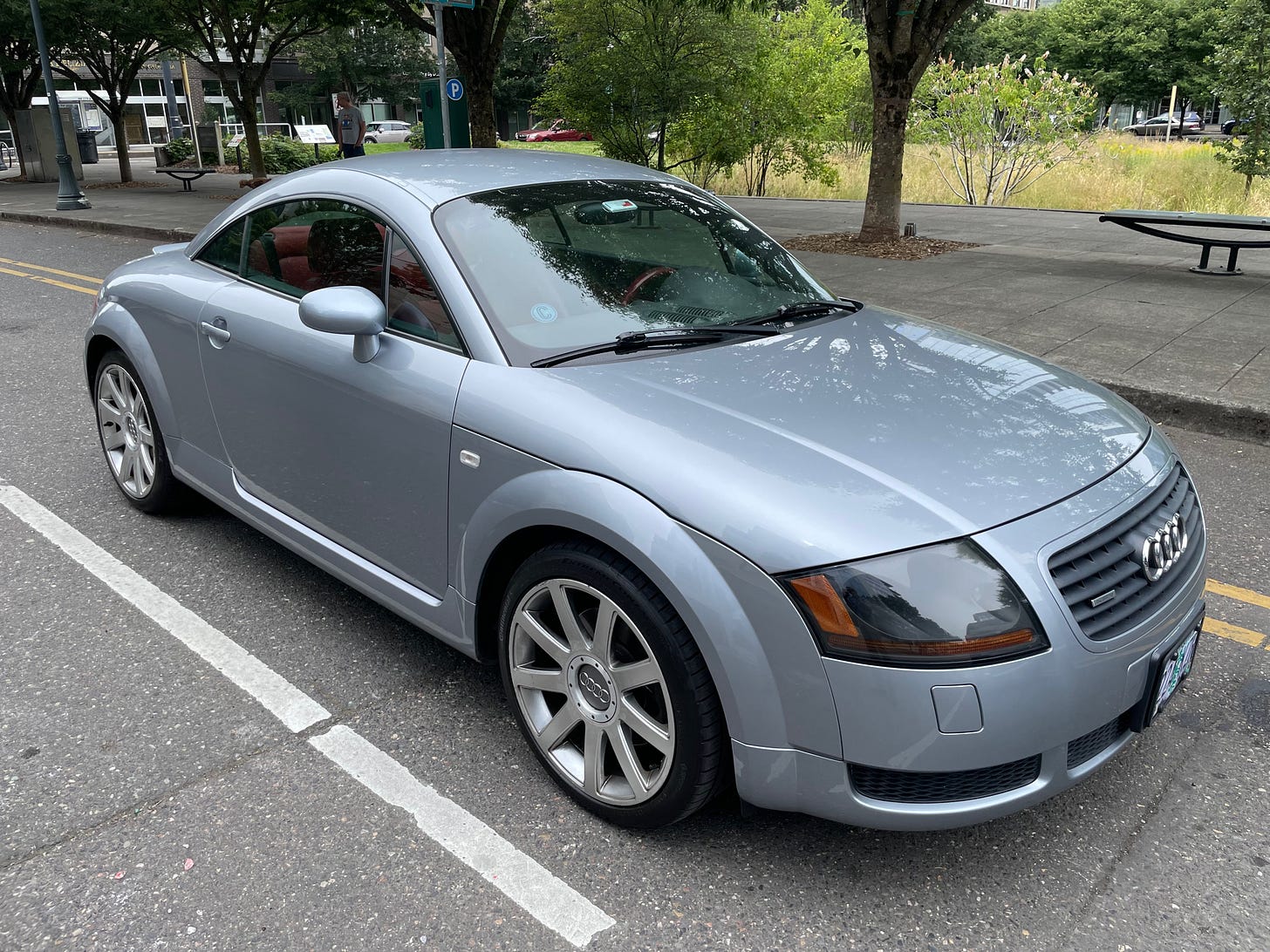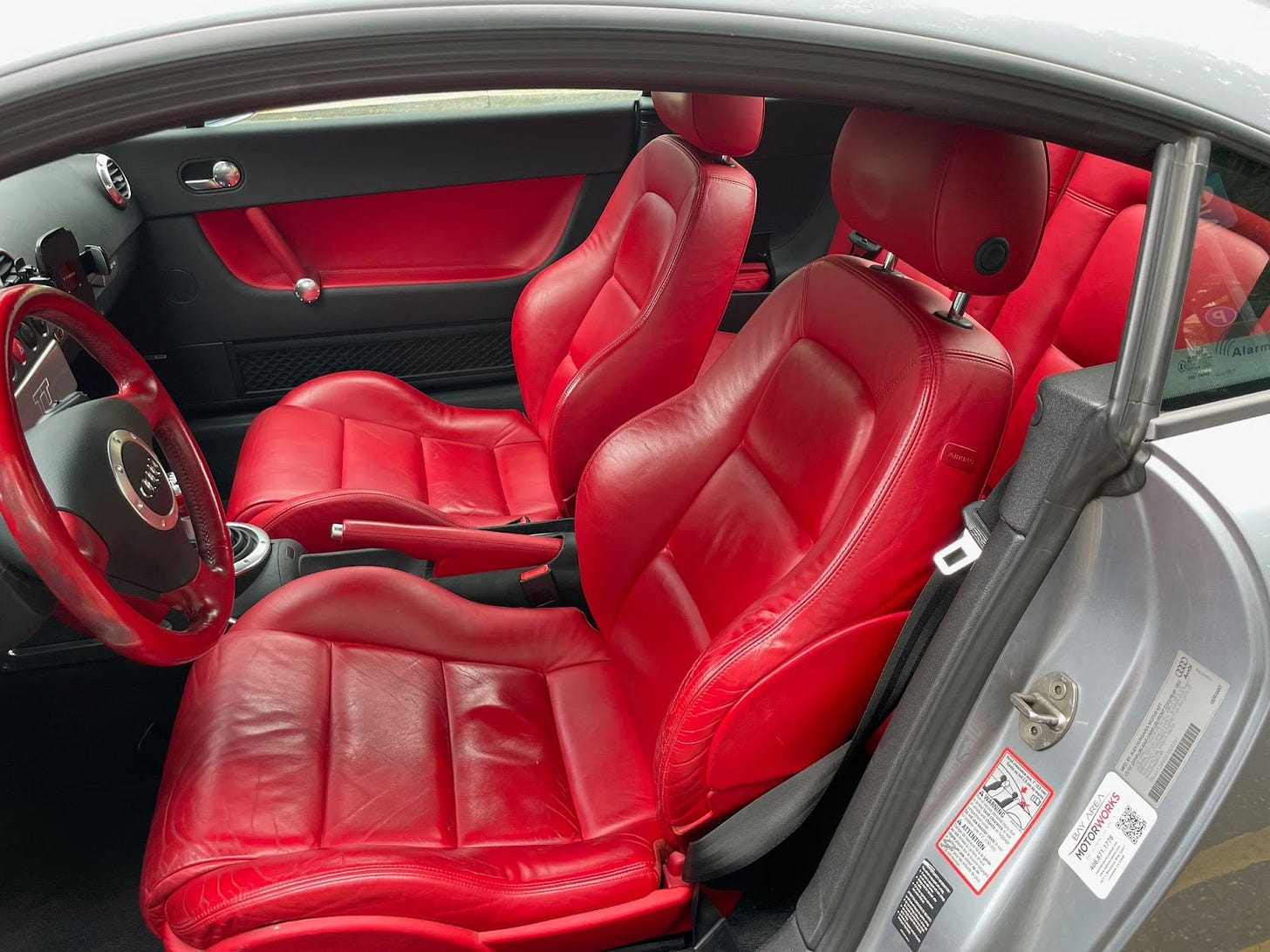Saying Goodbye to My Audi TT After 23 Years
Yesterday marked the end of an era. I sold my Audi TT after having it for 23 years—bought on July 7, 2002, and sold on July 8, 2025. For over two decades, this car has represented more than just a form of transportation. It’s been with me through five moves across three states, a classroom for my younger daughter to learn to drive a manual transmission, and a symbol of something deeper.
Just a day after selling the car, I am reflecting on the impact this car had on my views about happiness, our belongings, and how we hold onto them.
Why Did I Buy This Car?
I bought this car right before turning 35, and it made absolutely no sense for our lives at the time. We had two little kids — our older daughter was 4½ years old, and our younger daughter was a few days shy of 2. A two-seater sports car was perhaps the most impractical vehicle we could have chosen.
Looking back, it was probably an early midlife crisis. But it wasn't just about wanting a fancy sports car. When the Audi TT first came out in 1999, it was the only car on the road whose design felt genuinely inspiring to me. I appreciated how the production car remained almost unchanged from the concept car.
What really drew me to it was its origin story. The TT was designed as a repackaging of components from the Volkswagen-Porsche-Audi group, built on the VW Golf platform. It wasn't engineered to be the fastest or most powerful car; it was designed to look cool and establish a new design language for the brand. In many ways, it felt like a "product manager's car"—a vehicle born from strategic thinking about brand positioning and design philosophy rather than pure performance metrics. Those who worked with me back in my technology career know that I didn’t subscribe to the “better / cheaper / faster” philosophy and appreciated more nuanced product differentiation that could survive even if a competitor could match features, price, or performance.
By 2002, Audi offered a limited edition called the ALMS (American Le Mans Series). They made only 1,000 of them—500 in red with silver interior, 500 in silver with red interior. The rarity and distinctive look sealed the deal for me. I got the one with the red interior.
The timing wasn't coincidental. By 2002, I was about to turn 35 and had already burned out from Silicon Valley life. At 32, my second startup had gone public, and I was an officer of a publicly traded company navigating missed quarters during the dotcom bust. The stress felt overwhelming. In 2001, Marsha and I moved our family back to the Pacific Northwest to be closer to her family and rebuild our lives. This was a tumultuous period as Marsha’s dad passed away, I had joined a failing startup, and Marsha found us marriage counseling. The car purchase happened amidst a lot of change in our lives.
Despite the car making no practical sense, Marsha wanted me to be happy and encouraged me to get it. So I did.
What I Learned About Happiness
As much as I initially wanted this car, the biggest lesson I learned over 23 years is that things like cars don't actually make me happy.
In truth, I largely used the TT as a commuter car during my working years. As a family, we did all our weekend outings in our minivans—first a 1998 Plymouth Grand Voyager SE, later a 2005 Toyota Sienna AWD. The sports car sat in the garage while we lived our actual lives as a family in practical vehicles.
Over time I realized that what made me happy about the car wasn't the car itself. It was what the car represented — Marsha's desire for me to be happy. That gesture of support and understanding meant everything, and it still does, whether I physically have the car or not.
One of my favorite memories was teaching our younger daughter to drive manual transmission in this car. She had grown up with it and originally wanted to inherit it when she graduated college. The plan was always that it would become hers.
The End of an Era
Unfortunately, the timing just wasn't right for our younger daughter to take the car. When she graduated, she took a gap year traveling, then went to graduate school in England. Now she's working in Chicago with no desire to spend money on insurance or parking in a city where 27.5% of residents don't own cars, compared to 8.7% nationally. (Source: Wikipedia).
Meanwhile, the car was no longer fitting our lives in Portland. After giving our other car (a 2011 BMW 328xi) to our older daughter, the TT became our only vehicle. We quickly discovered the limitations of having a small two-seater as our only car, frequently renting vehicles for trips to Oregon wine country or even basic tasks like moving our kids’ stuff around.
The maintenance costs were also mounting. In 2023, we spent $3,000 replacing a broken air conditioner during a road trip. In 2024, over $2,500 in repairs. In 2025, another $3,000. While these costs were still less than new car payments, the downtime and hassle felt silly for people who rarely drive.
More importantly, I realized it wouldn't be a good car to give to our daughter anyway. I didn't want to lie awake worrying about whether a 23-year-old car would get her home safely.
When our new 2025 Toyota RAV-4 Plug-in Hybrid arrived on July 3rd, it was time to say goodbye.
The Last of Its Kind
This car represented a couple of "lasts" for me:
It was the last car I bought with a manual transmission. My automotive journey started with a 1990 Mitsubishi Eclipse GS Turbo (5-speed), then a 1994 BMW 325xi, then this 2002 Audi TT with its 6-speed. Manual transmissions are now essentially obsolete—I'll likely never own another one. I'm grateful our daughter got to learn this dying art.
(Marsha has her own manual transmission history, having driven her family's Subaru and owning a Honda Civic del Sol Si before switching to automatics when we got our minivans and later her 2011 BMW.)
This was also the last car I bought through the traditional dealership experience of walking in without a deal already negotiated. Back in 2002, it was common to shop at dealerships in person. I did this with the TT ALMS Edition at Barrier Audi in Washington. Without going into detail, the sales experience was so unethical that I walked out and closed the deal over the phone with University Audi in Seattle instead. From that point forward, I was determined never to enter a dealership again without terms already settled.
A Different Selling Experience
We've sold cars many different ways over the years—trade-ins for our 1990 Mitsubishi Eclipse and 1998 Plymouth Grand Voyager, consignment for Marsha's 1993 Honda Civic del Sol, Craigslist for our 1994 BMW 325i and 2005 Toyota Sienna (back when Craigslist was good), and to a friend for our older daughter's 2006 Audi A3.
This time felt different. The Toyota dealership's trade-in offer and CarMax's quote both felt low. I didn't want to deal with consignment lots or today's scammer-filled Craigslist. The car was too old to feel good about selling to a friend who wasn't a collector.
Instead, I sold it for $1,000 above the CarMax quote to someone who intended to list it on BringATrailer.com. I avoided the project of detailed photography, independent mechanical inspections, writing listings, and refurbishing to retail conditions. He got a car to work on over the summer with potential to make more money at auction. For me, he made it easy—I started the process on July 7th and had cash in hand on July 8th.
How Do I Feel?
A good friend compared a decades-old car to an old friend. He asked how I felt about saying goodbye.
Honestly, I feel pretty good. I had already separated the actual value of the "thing" from what it meant to me. The cool car itself didn't bring me happiness—Marsha's gesture of wanting me to be happy did, and that's still true whether I own the car or not.
In many ways, selling it now protects the memory. I no longer worry about expensive repairs or not having the car while it’s in the shop. The positive associations remain while the negative ones fade away.
Looking Forward
Now my first day into life without a car I had for 23 years, I'm curious about others' experiences. Have you owned a car for decades? What did you learn when it came time to let it go?





I bought my first car, a ford ka when I started my first internship back in 2001. At the time people referred to it as a hairdressers car, as was the stereotype, but it was all I could afford to insure and it was brand new out of the factory.
That car has five digits on the odometer and when I stopped driving it, it had 40K miles on the clock or actually 140K with the lack of digits.
It saw me through numerous relationships, jobs and finally meeting my wife, buying our family home and starting a life together.
When it went to the scrapyard but wife didn't have any nostalgia for it whatsoever, but to me it was a car full of memories. It's weird inanimate objects can do that to you, but one man's trash is another's treasure.
This is a great post. Thank you for sharing.